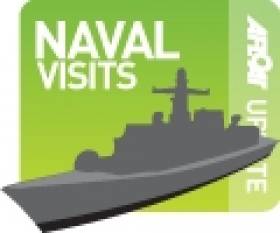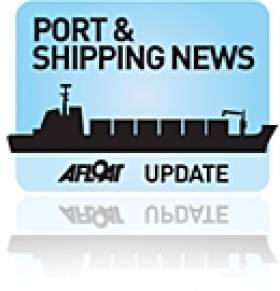Displaying items by tag: Gardian 10
Merseyside based UK Patrol Boat Berths in Dublin Marina
#NAVY VISIT – The Royal Navy's coastal training patrol boat HMS Charger (P 242) spent last night in Dublin Port having sailed from Liverpool's East Brunswick Dock. The vessel is based at the Commanding Officer of the Liverpool University Royal Naval Unit RN Headquarters on Merseyside, writes Jehan Ashmore.
The small boat measuring 20m in length and a beam of 6m remains this evening moored alongside the Poolbeg Yacht Boat Club Marina. The 100-berth facility faces Alexandra Basin where P&O Cruises Arcadia docked today.
HMS Charger is an Archer P2000 class patrol boat built by Waterfcraft Ltd of Shoreham. She provides practical navigation and seamanship training at sea where a crew recruitment unit takes place annually in early October from the universities in Liverpool and also from Lancaster University.
Last week HMS Charger called to Belfast Lough which included berthing in the city's Abercorn Marina basin next to the Titanic Quarter. Also visiting the basin this week was the newbuild WFSV Gardian 10 completed by Arklow Marine Services which was on a promotional delivery voyage to Great Yarmouth.
#PORTS & SHIPPING REVIEW – Over the last fortnight Jehan Ashmore reported the shipping scene which saw former Irish President Mary Robinson on board the National Geographic Explorer . She was a guest speaker during a 'Exploring the British Isles and Irish Isles' cruise.
An order for six 40,000 dwt bulk carrier newbuildings was placed by Irish based d'Amico Dry with China's Yangfan Group. D'Amico which is a fully owned subsidiary of the d'Amico group, has made the $134m deal, which values each handymax at $22.3m.
In advance of this weekend's visit of the London Olympic torch bearing tour to Ireland, the cruiseship Braemar called to Dublin Port. The vessel which was on a scheduled cruise is to be used as accommodation ship for key workers during the games for over a month, she is to moor close to the ExCEL Centre, which is to be used for a number of Olympic events.
On the ferry front the Isle of Man Steam Packet Company chartered the Arrow, a freight-ferry to cope with the increased volume in traffic associated with the famous annually held TT Races.
Along the south-west Irish coast, the small expedition cruiseship Clipper Odyssey made an anchorage call off Sneem on the Kenmare River. The 128 passenger vessel visited Co. Kerry having sailed the short distance from Cobh the previous day.
During the same week, two vessels met off Kilronan on Inishmore, Aran Islands. They were the cruiseship Island Sky which had started a cruise from Portsmouth and the lighthouse tender ILV Granuaile (2000/2,365grt) which is based in her homeport of Dun Laoghaire.
The last of the older Dublin Port tug fleet vessels Ben Eadar set sail on a delivery voyage for new owners in Portugal. While on the far side of the Irish Sea, the port of Liverpool welcomed its first turnaround cruise call in forty years in the form of Cruise & Maritime Voyages (CMV)'s Ocean Countess. However after leaving the Mersey, she suffered a temporary loss of engine power, forcing the vessel to turn around and divert to Holyhead.
Off the sunny south-east coast, the Expedition, a former Baltic Sea ferry converted to cruiseship duties anchored off the Saltee Islands. She sports a bright red hull still retained from her ferry owners, Viking Line, which the company choosed for their first ferry Apollo. Their choice in colour was found when one of the owner's relatives produced her lipstick!
Turning the corner at Carnsore Point and up to the boatyard of Arklow Marine Services where work on their latest newbuild Gardian 10 is nearing completion. The wind farm service vessel (WFSV) is due for launch later this month.































































